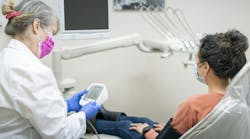The correlation between gum disease and stroke risk exposed: A wake-up call
A recent study reveals a connection between gum disease and a heightened risk of cryptogenic ischemic stroke (CIS), particularly among young adults with unexplained stroke causes. A study by Leskelä et al., “Periodontitis, Dental Procedures, and Young-Onset Cryptogenic Stroke,” investigated individuals aged 18–49 who had encountered their initial CIS.1 Further research is needed to confirm if maintaining healthy gums can lower the risk of stroke, particularly for those under the age of 50.
CIS refers to a subtype where the cause is not immediately identifiable despite comprehensive medical assessment. Ischemic strokes—which account for about 87% of all strokes—occur when an artery supplying blood to the brain is blocked, usually by a blood clot. In many cases, the underlying cause can be identified, such as atherosclerosis, cardiac arrhythmias (such as atrial fibrillation), or small vessel disease. Though less common overall, CIS is more characteristic in younger adults compared to older populations, where traditional risk factors such as hypertension, diabetes, and atherosclerosis are more prevalent.2
Gum diseases double the risk of young-onset CIS
The researchers noted that individuals with severe gum disease (periodontitis) had up to twice the risk of experiencing a stroke. Notably, these individuals did not have traditional stroke risk factors, such as high blood pressure or high cholesterol.1
The study also showed that patients who had advanced periodontitis—classified as stage III to IV, grade C—were 6.43 times more likely to experience a severe stroke compared to those without severe periodontitis. This indicates that periodontitis might not only potentially increase the risk of stroke but could also contribute to the stroke’s severity when it does occur.
The impact of recent dental treatments was also examined in the trial. According to the study, invasive dental treatments performed within three months prior to the stroke were associated with a higher risk of CIS, with an odds ratio (OR) of 2.54. This risk was even more pronounced in individuals with PFO who had an OR of 6.26. This finding emphasizes the potential impact of recent invasive dental procedures on stroke risk, particularly in those with certain preexisting health conditions.1
Bleeding gums are a red flag
Professor Pirkko Pussinen from the University of Eastern Finland, who participated in the study, emphasized that gingivitis and periodontitis affect most adults. She expressed concern that oral infections are often not taken seriously enough, despite the significant health risks they pose.
The professor highlighted a key warning sign: if your gums bleed when you brush your teeth, gingivitis (gum inflammation) is already present, and immediate action is required.
Pirkko Pussinen receives prestigious IADR Distinguished Scientist Award
The International Association for Dental, Oral, and Craniofacial Research honored Pirkko Pussinen from the University of Helsinki with the 2024 IADR Distinguished Scientist Award in Research in Oral Biology.
Pussinen, a professor of translational dentistry at the University of Eastern Finland, has a distinguished career in biochemistry and oral health research. She and her colleagues have been actively investigating the microbiology of periodontal disease for the past 20 years. Her research has focused on the identification of bacteria associated with periodontitis, the evaluation of the host response to these bacteria, and the connection of oral dysbiosis and inflammation in systemic processes such as atherosclerosis, as well as resulting diseases such as cardiovascular disease and stroke. Her group has published numerous peer-reviewed publications, meeting abstracts, and presentations.
The Research in Oral Biology Award, sponsored by Church & Dwight Company, is one of the highest honors given by the IADR, recognizing exceptional contributions to the field of oral biology.
The link between oral and brain health is a growing topic of interest. In March, Medical Licentiate Olli Patrakka examined in his dissertation in forensic medicine at the University of Tampere, Finland, the role of oral bacteria, particularly viridans group streptococci, in the development of strokes.3,4
Viridans group streptococci are normal microbes in the mouth, but once they enter the bloodstream, they can cause serious diseases such as endocarditis (infection of the heart valves). They can enter the bloodstream through inflamed gums, for example, while brushing teeth.3,4
“These bacteria adhere to the surface of the teeth and initiate the process leading to the formation of dental plaque. Our hypothesis is that a similar phenomenon occurs when bacteria that enter the bloodstream during dental procedures or gum infections migrate into the arterial walls. This may accelerate the development of atherosclerosis, or hardening of the arteries, and inflammation, contributing to both strokes and coronary artery disease,” Patrakka described.
Poor oral hygiene: A risk factor for stroke that needs more attention
According to Patrakka, dental bacteria can be found in the cerebral blood clots of stroke patients in approximately four out of five cases. This finding has not previously been reported.
Patrakka said, “For the study, cerebral blood clots from stroke patients treated in Tampere, Finland, were collected during acute care. Additionally, samples included endarterectomy tissue from patients with symptomatic carotid artery stenosis.”
Epidemiological studies have shown that poor oral hygiene is an independent risk factor for stroke, and improving hygiene habits may decrease the risk.5
“My research suggests that the connection might be specifically explained by an inflammatory reaction caused by dental bacteria in atherosclerotic plaques,” Patrakka continued.
The findings of the dissertation are significant as they open new possibilities for treating patients who have suffered a stroke. Patrakka speculates that “the development of a vaccine might also be possible.”
What practical implications might the new findings have for the treatment of stroke patients and health-care methods?
Dr. Tommi Pätilä, a heart and transplant surgeon at the New Children's Hospital in Helsinki, Finland, says, “The study reinforces the view that oral health must be maintained, especially for those at risk of stroke. Inflammation caused by oral streptococcal bacteria should always be considered in stroke prevention as part of regular dental care. It is also crucial to explore the potential benefits of timely antimicrobial treatment or a bacterial vaccine in the future.”
Studies show that dental plaque bacteria are responsible for about 95% of oral diseases.
Periodontitis is behind many ailments
Studies show that dental plaque bacteria are responsible for about 95% of oral diseases. One of the most common oral diseases is gum disease caused by dental plaque, known as gingivitis. Early signs of this widespread disease include red and bleeding gums, and bad breath. If the inflammation is not treated promptly and oral hygiene is not improved, gingivitis may progress to periodontitis, a more severe gum disease. Then fibers that attach the tooth are destroyed, leading to the formation of a pocket between the gum and the tooth. This pocket can expand around the entire tooth, destroying more of the tooth’s supporting tissues and eventually the jawbone.
Careful mechanical brushing of the teeth and cleaning between the teeth is important because even asymptomatic oral infections can affect overall health.
According to a Health 2011 follow-up survey, three out of four people in Finland over the age of 30 suffer from gingivitis, whereas half showed very mild signs of early periodontitis. Dr. Pätilä notes that this globally common oral disease can lead to tooth loss if left untreated, but it is also linked to systemic noncommunicable diseases (NCDs). Among the significant NCDs are diabetes mellitus, cardiovascular diseases, depression, neurodegenerative conditions, rheumatic illnesses, inflammatory bowel disease, gastric Helicobacter pylori, stroke, obesity, diabetes mellitus, and asthma.6
“Statistics show that people with healthy mouths live longer. Each missing tooth reduces life expectancy. This is talked about far too little,” says Dr. Pätilä.
According to Liljestrand et al., even a few missing teeth may indicate an increased risk of health issues such as cardiovascular diseases, diabetes, and even premature death. When individual risk factors for chronic diseases are assessed, the number of missing teeth could be a useful additional indicator for general medical practitioners.7
Frustrated with the commonness of gum infections and convinced that current toothbrushing is not enough, Dr. Pätilä and his team developed a new method to improve oral hygiene. Lumoral is a CE-marked medical device (not currently available in the US) that harnesses the power of dual-light therapy to effectively reduce dental plaque and bacterial load in the mouth. When used regularly as an adjunct to common oral hygiene, the antibacterial method has been shown to improve oral health and periodontal treatment results.8-10
Editor’s note: This article first appeared in Clinical Insights newsletter, a publication of the Endeavor Business Media Dental Group. Read more articles and subscribe.
References
- Leskelä J, Putaala J, Martinez-Majander N, et al. Periodontitis, dental procedures, and young-onset cryptogenic stroke. J Dent Res. 2024;103(5):494-501. doi:10.1177/00220345241232406
- Saeed S, Gerdts E, Waje-Andreassen U, Sinisala J, Putaala J. Searching for explanations for cryptogenic stroke in the young: revealing the etiology, triggers, and outcome (SECRETO): echocardiography performance protocol. Echo Res Pract. 2019;6(3):53-61. doi:10.1530/ERP-19-0025
- Patrakka O, Tuomisto S, Pienimäki JP, et al. Thrombus aspirates from patients with acute ischemic stroke are infiltrated by Viridans streptococci. J Am Heart Assoc. 2023;12(22):e030639. doi:10.1161/JAHA.123.030639
- Patrakka O. Studies on the bacterial microbiome in thrombus aspirates of ischemic stroke patients. Academic Dissertation. Tampere University. 2024. https://trepo.tuni.fi/bitstream/handle/10024/154588/978-952-03-3315-7.pdf
- Park SY, Kim SH, Kang SH, et al. Improved oral hygiene care attenuates the cardiovascular risk of oral health disease: a population-based study from Korea. Eur Heart J. 2019;40(14):1138-1145. doi:10.1093/eurheartj/ehy836
- Botelho J, Mascarenhas P, Viana J, et al. An umbrella review of the evidence linking oral health and systemic noncommunicable diseases. Nat Commun. 2022;13(1):7614. doi:10.1038/s41467-022-35337-8
- Liljestrand JM, Havulinna AS, Paju S, Männistö S, Salomaa V, Pussinen PJ. Missing teeth predict incident cardiovascular events, diabetes, and death. J Dent Res. 2015;94(8):1055-1062. doi:10.1177/0022034515586352
- Rydén L, Buhlin K, Ekstrand E, et al. Periodontitis increases the risk of a first myocardial infarction: a report from the PAROKRANK study. Circulation. 2016;133(6):576-583. doi:10.1161/CIRCULATIONAHA.115.020324
- Pakarinen S, Saarela RKT, Välimaa H, et al. Home-applied dual-light photodynamic therapy in the treatment of stable chronic periodontitis (HOPE-CP)—three-month interim results. Dent J (Basel). 2022;10(11):206. doi:10.3390/dj10110206
- Nikinmaa S, Alapulli H, Auvinen P, et al. Dual-light photodynamic therapy administered daily provides a sustained antibacterial effect on biofilm and prevents Streptococcus mutans adaptation. PLoS One. 2020;15(5): e0232775. doi:10.1371/journal.pone.0232775
- Nikinmaa S, Moilanen N, Sorsa T, et al. Indocyanine green-assisted and LED-light-activated antibacterial photodynamic therapy reduces dental plaque. Dent J (Basel). 2021;9(5):52. doi:10.3390/dj9050052
About the Author

Nina Garlo-Melkas, MSc
Nina Garlo-Melkas, MSc, is a health and science journalist.





